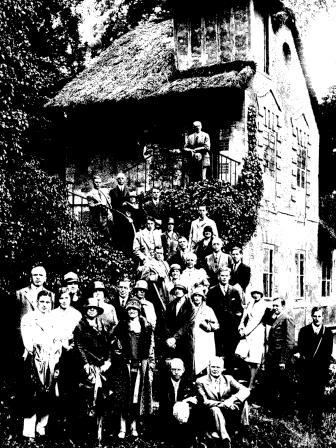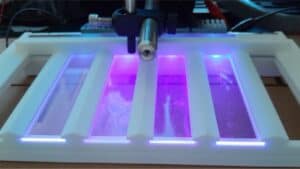








Our history
Founded in 1898, The American Ceramic Society was formed at a convention of the National Brick Manufacturers’ Association in Pittsburgh, Pa. It was there that several attendees banded together to talk about the scientific side of ceramics through a free exchange of ideas and research. Among the original founders were Elmer Gorton, Samuel Geijsbeek, Albert Bleininger, Edward Orton, Jr., Willard Richardson, Ellis Lovejoy, Gustav Holl, William Gates, and Carl Giessen.
View ACerS 100th Anniversary book online.
Learn more…
The first Society members worked as teachers, industrialists, engineers, geologists, chemists, and artists. The specific interest of these members included china, pottery, structural products, tile, and refractories. Edward Orton, Jr. served as secretary of the Society for 20 years and was the editor of the first nine volumes of the Society’s Ceramic Transactions. Learn more about his legacy here (PDF).
During these early years, the Society mirrored the ceramics industry and was truly clay-based, with the most common ceramic products being bricks, sewer pipes, tiles, glass, dinnerware, and china. The American Ceramic Society played a large role in turning the industry from narrow commercial interests to a broader scientific outlook.
The Society has witnessed many changes through the years, but the core mission has stayed the same: to advance the study, understanding, and use of ceramic and related materials for the benefit of our members and society.
Now, the Society has grown to more than 10,000 members consisting of scientists, engineers, researchers, manufacturers, plant personnel, educators, students, and marketing and sales professionals from more than 70 countries—with 40% of members based outside of the United States.
Today, the Society provides knowledge and forums to members who are shaping the way we think about materials science. From bricks, to cell phones and appliances, to space shuttle tiles and green technology, the members of the Society are leading advancements in ceramic technologies that keep people safe and warm, explore and discover new frontiers, and save lives. The American Ceramic Society is proud to be a conduit for these initiatives.
ACerS milestones
2022
The United Nations declares 2022 the International Year of Glass and ACerS convened the National Day of Glass conference in Washington, D.C., to kick off North American-based celebrations.
2021
ACerS develops and begins implementation of an updated Strategic Plan.
2020
The COVID-19 coronavirus pandemic strikes the world, leading to mass scientific conference cancellations, travel restrictions, social distancing, and other unprecedented prevention measures.
2019
ACerS forms the Energy Materials and Systems Division.
2019
ACerS launches the open-access International Journal of Ceramic Engineering & Science (IJCES).
2019
Mark Mecklenborg is named executive director.
2018
ACerS headquarters moves from Cleveland Avenue to its new location at 550 Polaris Parkway, Westerville, Ohio.
2018
All back issues of ACerS Bulletin become available through the Bulletin Archive Online.
2018
ACerS celebrates its 120th anniversary.
2017
Potters Council transitions to the International Ceramic Artists Network (ICAN) of the Ceramic Arts Network (CAN).
2017
ACerS forms the Bioceramics Division.
2017
ACerS forms International Chapters, beginning with the United Kingdom Chapter, followed by Chapters in India, Italy, Canada, and Germany.
2016
ACerS elects its first internationally-based president, William Lee, from the United Kingdom.
2015
ACerS Whitewares and Materials Division transitions to the Manufacturing Division.
2014
ACerS launches the Ceramic and Glass Industry Foundation (CGIF) to ensure the industry attracts and trains the highest quality talent available to work with engineered systems and products that utilize ceramic and glass materials.
2013
ACerS Art Division transitions to the Art, Archaeology and Conservation Science Division, a crossover membership of ACerS and Potters Council.
2012
ACerS forms the Young Professionals Network.
2010
Charlie Spahr is named executive director and serves until 2018.
2010
ACerS launches the International Journal of Applied Glass Science (IJAGS).
2008
ACerS forms the President’s Council of Student Advisors (PCSA) and holds its inaugural meeting in Daytona Beach.
2007
ACerS headquarters moves from Ceramic Place to 600 N. Cleveland Ave., Westerville, Ohio.
2007
The Cocoa Beach meeting of the Engineering Ceramics Division moves to Daytona Beach due to increased attendance and expanded number of exhibits.
2006
ACerS Annual Meeting combines with the Materials Science & Technology conference (MS&T).
2006
The first International Congress on Ceramics (ICC) is held in Toronto, Canada.
2006
Scott Steen is named executive director and serves until 2010.
2005
ACerS partners with Blackwell Publishing on the Journal of the American Ceramic Society and International Journal of Applied Ceramic Technology and ACerS members get free online access.
2005
ACerS forms the Material Advantage student program with ASM, AIST, and TMS.
2005
ACerS uploads all back issues of the Journal of the American Ceramic Society online as a free member benefit.
2004
ACerS launches the International Journal of Applied Ceramic Technology.
2003
Glenn Harvey is named executive director and serves until 2006.
2001
The Potters Council membership organization is established to serve the ceramic arts community.
2000
ACerS cosponsors National Engineers Week, February 20–26.
1999
ACerS revises and updates its governance.
1998
ACerS launches the Centennial Traveling Museum Exhibit.
1998
ACerS sponsors the first ceramics pavilion at the National Design Engineering Show and Conference in Chicago.
1998
ACerS 100th Annual Meeting takes place in Cincinnati, Ohio, May 4–7.
1997
Pottery Making Illustrated publishes its inaugural issue.
1996
The Society acquires Ceramics Monthly.
1996
Carol Jantzen, the first female president, is sworn into office.
1995
ACerS launches its first website.
1995
ACerS approves the American Ceramic Industry Association (ACIA), the first Society subsidiary.
1994
The inaugural biennial Ceramic Manufacturers & Suppliers Workshop & Exposition is held in Louisville, Kentucky, September 25–28.
1993
ACerS holds its first offshore sponsored meeting, PACRIM, November 7–10.
1990
ACerS begins an initiative in pre-college education programming.
1989
Advanced Ceramic Materials is incorporated into the Journal of the American Ceramic Society.
1986
The Society sells its building at 65 Ceramic Drive.
1986
ACerS holds a grand opening of its new headquarters at Brooksedge, December 4.
1985
Advanced Ceramic Materials publishes its inaugural issue.
1984
Paul Holbrook succeeds Arthur Friedberg as executive director and serves until 2003.
1982
The Society and the National Bureau of Standards sign documents launching the joint program on Phase Equilibria for Ceramists on December 21.
1981
ACerS dedicates the Ross C. Purdy Museum of Ceramics in Columbus, Ohio.
1981
“ACerS” is adopted as the official acronym of The American Ceramic Society.
1980
The first edition of the Advances in Ceramics series is published.
1979
Arthur Friedberg succeeds Frank Reid as executive director and serves until 1984.
1978
ACerS holds its first poster session at the 80th Annual Meeting in Detroit, Michigan, May 6–11.
1975
ACerS offers its first CEC short course: “Kinetics in Ceramic Processes.”
1973
The new Society-owned Ceramic Park office building is completed.
1970
ACerS establishes the Ceramic Endowment Fund.
1969
ACerS holds its first Exposition at the Sheraton-Park Hotel in Washington D.C., May 4–6.
1969
The Constitution is thoroughly revised and updated.
1968
For the first time, paid Society memberships and publication subscriptions exceed $10,000.
1966
The Design Section of the Ceramic Educational Council votes to split from the Society to form the National Council on Education for the Ceramic Arts (NCECA).
1964
ACerS publishes its first ceramic company directory.
1963
Frank P. Reid is named general secretary and serves until 1979.
1957
ACerS holds its first ceramographic exhibit in Dallas, Texas.
1954
The first Society-owned headquarters building in Columbus, Ohio, is dedicated on December 4.
1953
Ceramics Monthly begins publication in January.
1946
The Purdy collection of ceramic objects is given to the Society.
1946
Charles S. Pearce is named general secretary and serves until 1963.
1938
The Board of Trustees approves the formation of classes.
1937
Engineering curricula are accredited for the first time.
1936
At the 38th Annual Meeting in Columbus, Ohio, March 29–April 4, sessions are split between two hotels for the first time.
1935
The Association of Ceramic Educators is organized.
1933
The summer excursion meeting is held in Chicago, Ill. during the Century of Progress Engineers’ Week, June 25–30.
1933
E.W. Washburn delivers the first Edward Orton, Jr. Memorial Lecture on February 14.
1931
153 members are elevated to Fellows at the first induction ceremony in Cleveland, Ohio on February 25.
1930
The Glass Division is the first division to hold a fall meeting, at Cove Point, Maryland, October 4–6.
1930
The first 100 Fellows holds their organizational meeting.
1930
Edward Orton, Jr. becomes president of the Society.
1929
February 4–9 is designated as National Ceramic Week and the first exposition of ceramic products in America, coinciding with ACerS 31st Annual Meeting, held in Chicago, Ill.
1928
The Society holds its summer tour in Europe.
1926
The Society moves its offices to 2525 North High Street in Columbus, Ohio.
1925
The first high school ceramic courses are taught in East Liverpool, Ohio.
1925
Ceramic Day is observed at the Chemical Exposition Fall Meeting.
1925
Ohio State University celebrates the 30th anniversary of the founding of ceramic education.
1922
ACerS publishes Volume 1 Number 1 of the Ceramic Bulletin in May.
1922
Combining its editorial offices in Illinois and business offices in Columbus, the Society relocates to new headquarters on the Ohio State University campus in Columbus, Ohio.
1905
The Society files its Articles of Incorporation at the office of the Secretary of State in Columbus, Ohio.
1902
The summer excursion meeting, a “wholly social event,” takes place September 5–8 at the World’s Fair in St. Louis, Missouri.
1902
The Society translates and publishes the collected works of Hermann August Seger as its first major project.
1902
Rutgers University establishes its ceramic school.
1902
Beta Pi Kappa, the ceramic engineering fraternity, is established at The Ohio State University.
1901
The first associate members are elevated to full members at the third Annual Meeting.
1900
The New York State School of Clay-Working and Ceramics is established and run by founder Charles Fergus Binns.
1899
The Society publishes the first volume of Transactions of the American Ceramic Society.
1899
The first summer excursion meeting takes place July 4–7, with a session aboard the Put-In-Bay Steamer en route to Put-In-Bay, Ohio.
1899
The first meeting to organize a permanent organization is held in Orton Hall with Edward Orton, Jr. as secretary.
1898
The formation of a new ceramic association is discussed during the National Brick Manufacturers’ Association meeting, February 15–18, in Pittsburgh, Pa.
1894
The first ceramic engineering course is established by Edward Orton, Jr. at Ohio State University.
Join ACerS today
Become a part of a community that will be with you for your entire career—join ACerS today!

